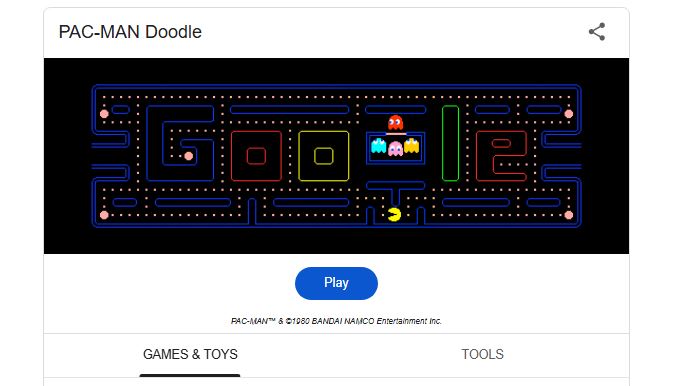A straightforward Google Doodle that turned its homepage into a playable homage to Pac-Man, one of the most famous video games ever, captured the attention of millions of people in 2010. The Google team gave their standard logo an interactive twist as part of a celebration for the game’s 30th anniversary. Instead of merely showcasing the recognizable “Google” letters, the homepage itself was transformed into a nostalgic Pac-Man arena.
Players could take control of the yellow, pellet-chomping Pac-Man in this Doodle as he made his way through a maze and avoided colorful ghosts that were trying to capture him. The gameplay remained faithful to the original version that debuted in arcades in 1980: a straightforward but engrossing blend of reflexes, quick thinking, and logic. This short, enjoyable diversion was more than just a lighthearted nod to the past of gaming. It demonstrated how a multinational corporation like Google could embrace the rapidly expanding trend of digital interactivity while simultaneously establishing a deeper connection with consumers through nostalgia.
Key Features of Google Pac-Man
| Feature | Description |
|---|---|
| Gameplay | Navigate Pac-Man through a maze, collecting pellets and avoiding four ghosts. |
| Accessibility | Play directly on the Google homepage, no downloads required. |
| Graphics | Retro 8-bit visuals with the classic Pac-Man maze and characters. |
| Sound | Familiar sound effects and theme music from the original arcade game. |
| Difficulty | Designed to be accessible for all skill levels, with automatic adjustments as the player progresses. |
| High Score Feature | Track scores and challenge friends or the community for top rankings. |
| Integration | Seamlessly integrated into Google search, allowing players to switch between searching and playing with ease. |
| Legacy | Celebrates the 30th anniversary of Pac-Man, linking past gaming memories to modern digital experiences. |
The simplicity of Google Pac-Man is what makes it so appealing. Even though it is a retro game, it is incredibly accessible to audiences today, making it the perfect way for anyone with a few spare minutes to decompress or take on a light challenge. Players of all ages enjoy it because of its simple yet challenging design, which promotes both casual play and competitive high scores. Actually, it’s about experiencing a piece of video game history rather than just playing the game. While the game introduces younger players to a significant turning point in the history of gaming, for others it evokes memories of packed arcades.
When the Doodle became one of Google’s most-played Doodles, it was evident how popular it was. Millions could jump right in without having to deal with installing software or downloading apps because it was instantly accessible from the homepage. And in true Google fashion, it was more than just a quick experience; it was carefully considered and designed with enjoyment in mind.

It’s interesting to note that the game evolved rather than merely paying homage to the original. It included improvements that gave the game a new and exciting feel for modern players while adhering to the fundamental mechanics of the 1980 arcade version. It was simple to switch between search results and gameplay because the ghosts moved in slightly different patterns and the gameplay was seamlessly incorporated into Google’s interface.
However, the experience is more than just a nostalgic one. It also demonstrates how gaming has changed to adapt to new technological advancements. The Google Doodle version of Pac-Man ushered in an era of instantaneous, browser-based gaming, allowing players to enjoy the same gameplay without any physical limitations, whereas the original Pac-Man game required actual arcade machines and coins. A significant turning point for gaming’s online presence was the game’s availability on Google’s homepage, which enabled users to start playing games with just a mouse click.
Google’s Pac-Man app, along with other versions that offered more challenges and updated features, soon emerged for those who were nostalgic for the game but wanted more than just the Doodle. Variations were available on computers, tablets, and mobile devices, each of which brought something fresh to the traditional experience. These iterations offered something for everyone, including updated mazes and themed challenges. There was a version to suit your needs, whether you were looking for the challenge of avoiding ghosts on an antiquated maze or you were itching for something new.
It’s critical to acknowledge how games like Pac-Man influenced the development of interactive entertainment in the future as the gaming community continues to change. Millions of players first encountered the idea of high scores, timed challenges, and the excitement of finishing progressively challenging levels thanks to Pac-Man. Since then, these ideas have established themselves as mainstays in the gaming industry, impacting the creation of innumerable contemporary games, including console games, mobile apps, and even esport competitions.
Because of its straightforward gameplay mechanics, Pac-Man can be enjoyed by a variety of players, from young children honing their hand-eye coordination to adults looking for a nostalgic diversion. It is perfect for brief gaming sessions because it also capitalizes on the larger trend of gamification, which allows players to play for brief periods of time. Games like Google Pac-Man are an effective way to get people involved because they bring them into enjoyable activities that improve their everyday routines.
Games like Google Pac-Man provide a useful lesson in how technology can improve daily experiences in today’s fast-paced digital world. Engaging gameplay and nostalgia have a lasting place in the entertainment industry, as demonstrated by the fact that something as basic as a maze and a few ghosts can win over millions of hearts. The timeless design of Pac-Man is still incredibly relevant and unites people, whether you’re reliving memories or introducing a new generation to its allure.
